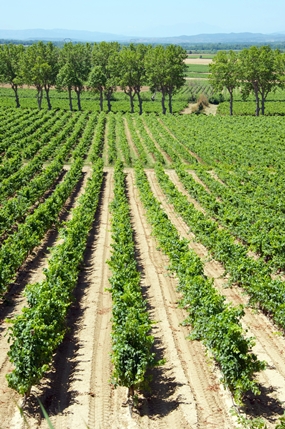A wine company with the name “Mau” would probably induce much merriment among Thai people. As almost everyone knows around here, in Thai the word means “drunk”, provided you pronounce it with a short vowel to rhyme with “cow”.
Actually, few people would drink wine for the sole purpose of becoming intoxicated, especially in Europe. In any case, there are much cheaper ways of getting stoned. Wine is woven into the fabric of European culture and it’s not just a drink for special occasions. In many countries and especially in France, Italy and Spain, many people would consider a meal incomplete without wine, even if it’s just a bottle of cheap plonk to enhance the food. It takes its place on the table as naturally as salt and pepper.
 An Yvon Mau vineyard, in Languedoc Region of Southern France.
An Yvon Mau vineyard, in Languedoc Region of Southern France.
For a variety of social and economic reasons, drinking is in decline in many European countries, yet among wine consumers, the French still seem to be top of the list. In 1897, in the curiously-named French town of Gironde-sur-Dropt, the Yvon Mau wine-trading company was founded. These days, you can find Yvon Mau wines in 160 countries, yet its headquarters remain in the same town in which it was established over a hundred years ago.
Yvon Mau Colombard-Chardonnay 2009, (white) France (Friendship, Bt. 480)
This dry, white wine comes from the C๔tes de Gasgogne, or what the British prefer to call Gascony. The British are notorious for their penchant for anglicising any foreign names that they can’t be bothered trying to pronounce. Although you don’t see the word “Hock” very often these days, it used to be common in the wine trade to describe Rhein wines. It’s an anglicised version of the German word Hochheimer, meaning “from the town of Hochheim”. In nineteenth century Britain, the word “Hock” was used indiscriminately to describe virtually any German wine. Sherry of course, is a corruption of “Jerez” and even the word “plonk” is a mispronunciation of the French word blanc (white), as in vin blanc.
The C๔tes de Gasgogne is a large area of South-West France that stretches from the wine region of Bordeaux right down to the Spanish border. It’s famous for the brandy known as Armagnac and is also the home to that horror of all vegetarians, fois gras.
So let’s get to the wine. (And about time too – Ed.) This one is made from Colombard blended with 25% Chardonnay. It has a light, clean straw colour and there’s a delightful fruity and floral aroma of white fruit, peaches, banana with faint hints of citrus. You’ll notice a soft mouth-feel with plenty of fruit up-front and a lovely zesty dash of acidity that fairly tingles in the mouth. It’s a medium-bodied wine, with peaches and vanilla on the palate and there’s a very long dry finish with hints of lemon. With just 11.5% alcohol content, this is a really well-made wine and the tingly freshness would make it a fun ap้ritif.
Yvon Mau Merlot 2009, (red) France (Friendship, Bt. 480)
This attractive wine comes from much farther to the east. The Aude is an area in the South of France adjoining the Mediterranean. It’s part of Languedoc-Roussillon; a land surrounded by hills and mountains which reaches down to the foothills of the Pyrenees. This wine is a vin de pays (country wine) so it’s a step up from ordinary table wine.
It’s a pleasing ruby red with a sweet aroma of red cherries, raspberry jam, a touch of spice and some distant woodland smells. There’s plenty of ripe berry fruit on the taste, a very soft clean mouth-feel and virtually no tannin to speak of, although a little comes through on the long, dry herby finish. This smooth, easy-drinker is light-to-medium bodied with only a subtle hint of sweetness.
If you can imagine a scale from zero to ten (in which ten is the sweetest), I’d put this wine in about number two. Unlike many dry reds that seem to demand food, this is an easy quaffer (it’s only 12.5% alcohol) and is friendly enough to go it alone. But oh dear, what a drab label! Never mind; just tip the whole lot into a decanter and give the wine a good airing at the same time.




